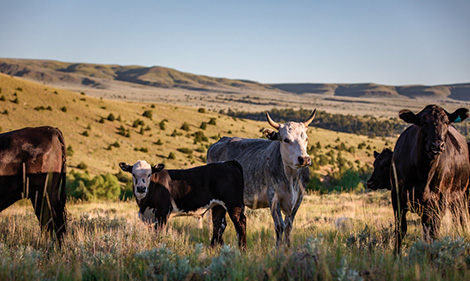Insights on agricultural commodities and drought conditions
Drought and water access updates
Precipitation levels have generally been below average across the West for 2024. Drought conditions have worsened in California, Arizona, Idaho and eastern Montana, while Oregon and Washington have experienced improvements. Reservoir levels generally weakened over the last quarter, and multiple regions continue to see reservoirs with water levels below 80% of their historical average.
Read more about the latest national regulations and regional conservation agreements affecting water availability and use in Arizona, California, Idaho and Oregon.
Major commodity insights
AgWest’s outlook for major commodities is summarized below. Visit AgWestFC.com/industry-insights to view expanded analysis for each industry, monthly economic headlines, relevant data and trends, and additional special reports.
Almonds and pistachios
Producers are cautiously optimistic for the 2024-25 season. Prices have increased due to lower supply, but the spread between demand for lower and higher grade nuts has narrowed. Lower pistachio yield, minimal carry-over and generally favorable quality should continue to support prices, and demand is reportedly strong heading into the 2024 marketing season. Expanding water restrictions across irrigation districts cause concern for growers on white lands. A reduction in supply would improve prices but could impact grower profitability.
Apples
Supply aligns with demand, and apple growers are cautiously optimistic for the 2024-25 season. While lower supply following a record unprofitable 2023-24 season should support grower profitability, packers without sufficient throughput volume may come under pressure in the coming years. Pear producers in the southern growing regions should see an increase in profitability due to good crop combined with a very short pear crop for northern producers. 2024 cherry prices support profitability but were below initial expectations.
Cattle
Beef production increased by 3% in 2024, with a slight drop in slaughter rates but higher carcass weights. Feedlots maintained capacity despite fewer cattle, drought conditions, and declining feeder supplies. Inexpensive hay has led producers to restock. U.S. meat exports remain strong, and imports meet local demand but are expected to decrease with herd rebuilding. Beef producers are concerned that future Dietary Guidelines may favor plant-based alternatives over red meat.
Dairy
Improved margins due to lower feed costs and increased milk prices have helped dairies recover, but expansion remains limited. With historically low heifer inventory, it will take time for herds and milk production to grow, even with better margins. Production is expected to rise slightly in 2025 and prices are expected to fall below 2024 levels, but futures markets suggest margins will remain positive. Lower priced plant-based milk alternatives could pose a long-term challenge to traditional dairy sales.
Forest products
Little has changed over the past year outside of capacity curtailments in the West. Interest rates are expected to decrease, resulting in increased construction and remodel activity and subsequently improved log and lumber prices. Log exports remain generally strong for West Coast producers, although lumber exports out of the Southern U.S. are outpacing the West.
Hay
Hay prices remain low across the West, with producers facing challenges from water shortages, low profitability, and competition from alternative crops. Demand for hay is weak, except for small bales, indicating a challenging market for hay producers. Montana hay production matched 2023 levels but varied by region. Drought conditions could boost demand. Idaho’s production declined due to rain damage and pest issues, while Washington and Oregon’s production increased slightly. Despite extreme heat in the Southwest, production in California and Arizona increased.
Oranges and lemons
California's current citrus harvest brings challenges and opportunities. Early-season heat stress has resulted in smaller size and slow color development for navel oranges, creating uncertainty about profits despite strong initial prices. Early harvest reports on mandarins suggest similar concerns. The outlook for Valencia oranges is positive, with favorable quality expected and juice prices anticipated to remain strong in the near term. Lemon quality is generally good, although there are reports of smaller sizes in some regions. With weak prices, growers are facing break-even margins.
Potatoes
The oversupply of potatoes in 2024 has resulted in depressed prices. While production is down slightly in the West, demand remains weak, particularly from restaurants and for frozen potato products. The closure of a processing plant in Washington further highlights weakening consumer demand. Water allocation uncertainties, particularly in the Klamath Basin, add to the industry's challenges. Producers are facing difficult decisions about future planting and are limited in profitable crop alternatives.
Wheat
The early outlook for the 2025-26 winter wheat crop is concerning, with only 38% of the national crop rated good to excellent. While western states are in better shape, Montana is lagging. Despite strong export forecasts for the current crop year, producers are pessimistic about the future due to low projected prices and high costs, making profitability difficult. Many will rely on crop insurance to break even. Global wheat production is also threatened by dry conditions in major exporting countries.
Wine and wine grapes
Wine grape quality is generally good in California, but yields are down and prices for uncontracted grapes remain weak. In Washington, yields and quality are average with some smoke taint and frost damage reported. Markets for uncontracted grapes are nearly nonexistent and there are reports of contract breaches. The Walla Walla region was an exception, experiencing both good quality and pricing for the 2024 crop. Yields and quality are generally favorable in Oregon, but prices vary widely. Some growers face limited markets, while others with contracts or established reputations are seeing strong prices. Some acres went unharvested due to oversupply.
